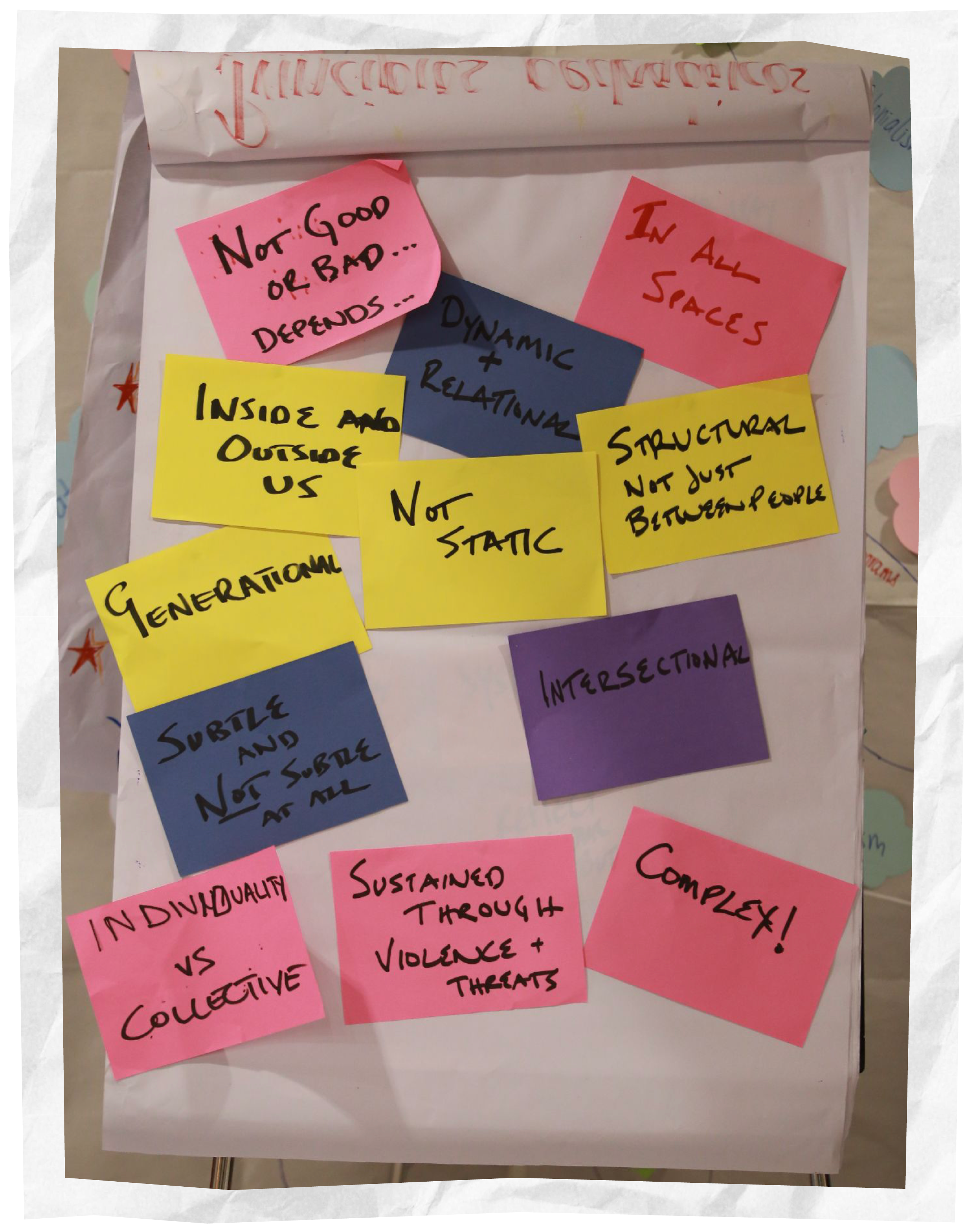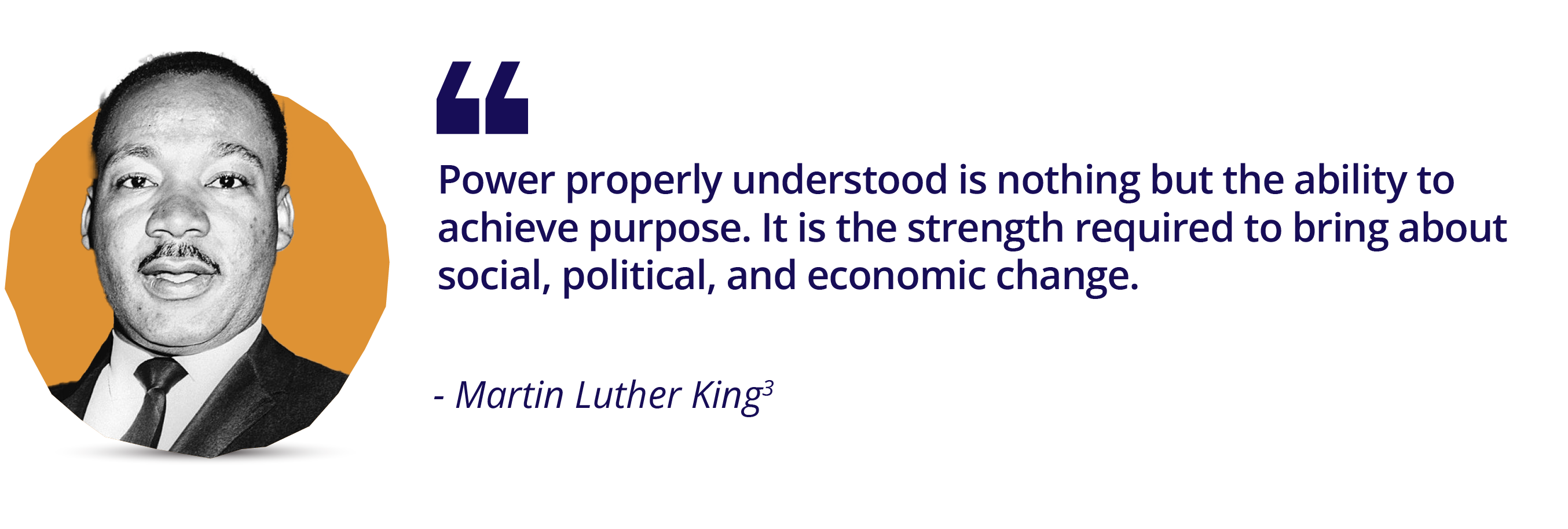Theme 1: What and Where is Power?
Power is an ever-present aspect of our lives and work. A good place to begin is our own lived experience – how we internalise and encounter power every day and what we do about it – rather than using abstract definitions and frameworks. Power can be uncomfortable to talk about, because we’ve all felt, witnessed, and even internalised oppressive forms of power.
Activity 1: Power and powerlessness
Everyone has experienced power dynamics in different ways in their lives. In this activity, we explore what power means to us and uncover aspects of our own power before introducing new information and ideas.
Step 1. Power drawings
Materials: Sheets of letter-size/A4 paper, coloured pens, flipchart, handout: What and where is power?
Individually: Give each person a sheet of paper and pens and ask them to:
- Draw a line down the middle.
- On one side of the line, draw a situation where you felt powerful.
- On the other side of the line, draw a situation that made you feel powerless.
- Choose specific moments and situations rather than “a general time when…”.
- Focus on something you are comfortable sharing with others.
Remind everyone that the quality of artwork is not important. A simple line drawing can help us see our experiences with fresh eyes. Draw or find images that reflect feeling powerful/powerless, since images can be highly evocative. Or choose a few words that capture your experience.
Small groups: Each of the three or four people in a group has five minutes to explain their drawings or images, share their experiences, and speak to the following questions:
- What was it like to feel powerless?
- What caused you to feel powerless?
- How was power used or experienced to control your actions or suppress your voice?
- What made you feel powerful, and why? How did you use or express your power individually or with others to enhance your life, make your voice heard, or change a situation?
Plenary: For a gallery walk, each group posts drawings and images on the wall. In turn, each group presents a quick synthesis of their reflections. Then, together, discuss the feelings that people have shared, identifying the different experiences of power, powerlessness, or feeling powerful. Draw out people’s own understandings and meanings. Invite them to share concepts or definitions of power or empowerment from their prior experience. As the facilitator, record these so everyone can see the evolving ideas. Ask guiding questions:
- Looking at all the drawings and reflections, what is it like to feel powerless or disempowered? What is it like to feel powerful?
- What do these drawings show us about the different ways that power operates?
- What do you conclude about power from this process? What insights have you gained?
Individually: Think about power, powerlessness, and feeling powerful. Each person writes down on a card, in large letters with a bold marker, a short statement or a few words describing each of these terms.
Small groups: People choose the term that interests them most: power, powerlessness, or feeling powerful and form groups to discuss it. In their group, people share their thoughts and create a symbol or drawing together with a short definition. Encourage them to use metaphors and write/draw their ideas on a piece of flipchart paper or using digital tools to share in plenary.
Plenary: Groups take turns to present their ideas and invite quick responses. Keep the pace brisk. Facilitate a discussion, making note of key points:
- What do our drawings show us about the nature of power?
- What kinds of negative and positive power did you see? What are some of the sources and uses of power from these examples?
- What are different ways power operates in our contexts?
Step 2. Enact a scene or embody a sculpture
This can be an addition or an alternative to Step 1. If time allows, go through both steps. Use this process to extend and embody understandings of power, building directly on the drawings and stories shared in Step 1.
Small groups: Choose one picture, story, or combine elements of more than one story. Aim to convey the feeling of experiencing power and/or powerlessness through either a body sculpture or skit.
A body sculpture can be silent or include repetitive motions or sounds. Design the positioning of group members by improvising.
- To make a body sculpture, position yourselves in a way that symbolises or best reflects your experience of power or a snapshot of one moment.
Or if using a skit or scene:
- Enact one part of the story.
- Choose whether to mime (using silent acting) or include short dialogue or sounds.
- Allocate roles, dialogue (if any), and action.
- Keep the scene short.
Using our bodies in this way can be challenging, especially if we have experienced trauma in our lives. Explain that anyone not comfortable with acting in a scene or body sculpting can just observe. Be aware of your own actions and movements and how others might experience them. Initiate any physical contact gently and slowly, leaving spaces between actors (unless your group is experienced with theatre and comfortable with physical contact). Be mindful of cultural and gender differences in what is acceptable for physical interaction and contact between people in an exercise or presentation.
Plenary: Designate a stage area on one side of the room where groups take turns to perform their scenes and body sculptures. After each performance, ask the audience to share – in just one or two words – what they felt seeing the sculpture or scene. Then ask a few to share what they think was happening. Finally, ask the group who performed to explain the sculpture or scene.
Keep the debriefs after each performance short. Draw out the embodied experiences and feelings of both the performers and the audience. Hold off on more analytical or conceptual discussion until all groups have performed.
After all the presentations and reflections, engage the group in summarising the feelings they have expressed and experienced by acting and watching. Then identify the different kinds of experiences of power, powerlessness, or empowerment that were represented, drawing out participants’ own understandings and meanings. Invite participants to share any useful concepts or definitions of power or empowerment from their prior experiences and knowledge.
Step 3: What is power?
Distribute copies of the handout: What and where is power? for everyone to read
Plenary: With reference to groups’ presentations from Steps 1 and/or 2, discuss:
- What resonates with your understanding?
- What is new or different?
- What do you conclude about power from this process?
- What further insights have you gained?
Summarise key points, and note that the group will return to these meanings of power and enrich them with further definitions and frameworks in later activities.
Download this activity.

What and where is power?

Power is …
- Everywhere – within groups, individuals, and nature.
- Part of our everyday lives and interactions.
- Neither good nor bad – that depends on who is using it, how, and for what ends.
- Relational, dynamic, and messy.
- Experienced differently in the public, private, and intimate arenas of our lives.
- Structural, systemic, and institutionalised.
- Entrenched but not static; when unequal, it is always in dispute and contradictory.
- Intersectional, impacting us differently depending on gender, race, ethnicity, caste, class, sexuality, ability, location, and more.
- Fluid and changing depending on the context and moment.
- Held in our bodies, hearts, and minds – internalised and often unconscious.
Power, if unequal, is always in dispute
Power works at all levels of our lives – personal, social, cultural, political, economic, systemic – in both good and bad ways. Power shapes what we do, what is done to us, and how we think and act. When power is unequal, there is always a push and pull, and conflict over:
- Who ‘we’ are
- Who decides and makes the rules
- Who and what matters most
- Who gets what
- Who does what
- What is ‘normal’
- Which ideas and beliefs ‘count’

Power over is extractive, exploitative, and oppressive.
Power over operates in a zero-sum universe where some have it and others don’t, an ‘us’ vs ‘them’ competitive approach to power where those with more power resist change. Power over is embedded in all structures and maintained through social conditioning, the control of rules, access to resources, coercion, narratives, fear, and violence. It can be resisted, challenged, subverted, and transformed.
Transformative power is liberating and generative, seeking to change the inequities and injustice of the status quo.
Shaped by a consciousness of abundance, a commitment to liberation and justice and a belief in the possibility of deep change and a vibrant future for all, it is built over time by inclusive visions expressed through strategies for change. This enables us to foster community and belonging, and to push back and contest power over. Transformative power takes many forms:
- Power within (dignity, confidence, and self-esteem)
- Power with (solidarity and collective action)
- Power to (capacity to act)
- Power for (vision and values – the purpose for which we build other forms of power)
Power is not static
Even where power over is dominant and entrenched, contradictions exist, and resistance is present. These are the cracks where the light comes in, that offer opportunities for change, however small or gradual. Transformative power is a continuous struggle against the deeply internalised and systemic patterns of power over that permeate our lives. Therefore, it involves conflict as we challenge the status quo – personal, professional, and political – and demands that we cultivate relationships of trust and solidarity, practices of safety and care, self-awareness, thoughtful analysis, and strategic action.
Download handout: What and where is power?.
______________________________
3 US civil rights leader
